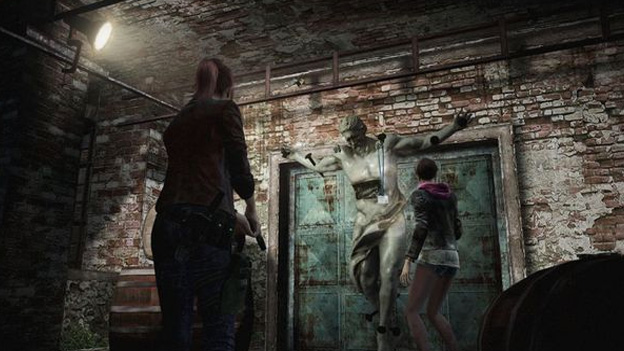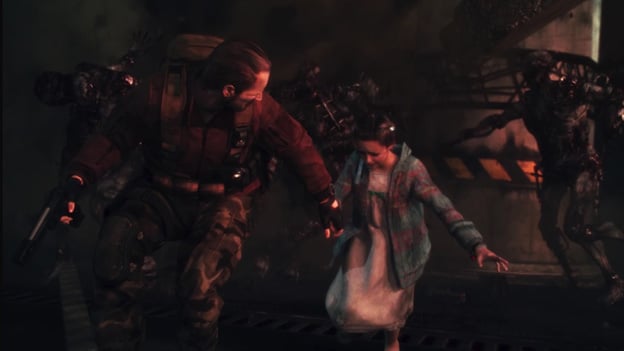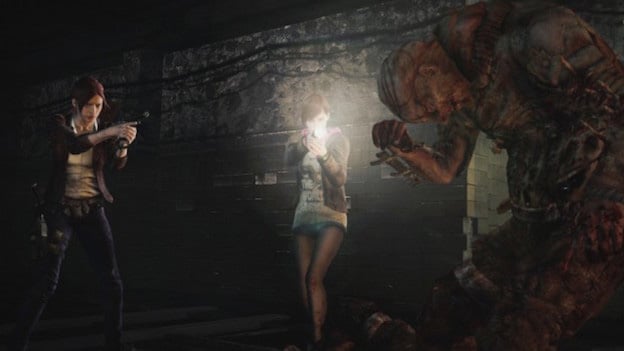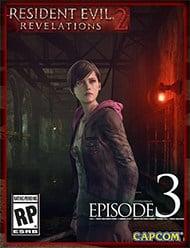What a Puzzler
Resident Evil Revelations 2: Episode 3 Judgement continues the ongoing story of RE:R2 , once again switching up the tone and feel of the game. While Episode 1 felt like something of a tutorial and Episode 2 felt like a more hardcore combat challenge, Episode 3 swings to the other side and focuses on puzzles. Once again this makes the game a joy to control, but the fact that each episode is focusing on such incredibly different gameplay mechanics makes me feel as if the entire game when put together may start to feel inconsistent.
Much of the framework here is the same as the past two episodes. We are looking at the same controls, same enemies, same characters, same voice actors, and same incredibly boring grey-brown environments which have really started to grate on me at this point. If you simply looked at screenshots of Episodes 1 , 2 , and 3 , you wouldn’t be able to tell the difference. If anything feels uninspired, it’s definitely the environments, and you feel that even more in Episode 3 because of how many puzzles there are.
That being said, the renewed focus on puzzles actually does quite a bit to change the way the game plays. First of all, it gives a much needed rest from the combat oriented Episode 2 . Second, it gives the game a sense of horror, which no other episode really managed to do up until this point. The slow moving progress through mind-bending segments makes you wonder when the other shoe is going to drop. Enemies usually only interrupt you at the worst of times, so you are always looking over your shoulder, waiting for someone to ambush you when you are pushing a box or flipping a switch.
So now RE:R2 has managed to give up one episode of survival and one episode of horror. Perhaps the next episode will finally bring them both together?

The puzzles also make this game a blast to play in co-op, far more than any previous episode. One of the glaring shortcomings of the game so far was that the combat character was far more fun to play in co-op mode than the secondary character. The special abilities of these characters came into play a little in previous episodes, but they still only served to make the combat character more effective.
However, both characters are pretty much equal when it comes to solving puzzles. Ether character can pull switches or push boxes. In fact, the secondary characters sometimes have extra abilities that the combat characters don’t, like the ability to fit into small spaces and access extended portions of certain levels. In a way, they take center stage this time around, doing more than the combat characters do, and when you and a friend figure out the solution to a puzzle, you get the rewarding eureka moment.

Unfortunately, the same thing that makes this episode fun to play in co-op makes it a slog in single-player. The puzzles seem designed for two players to work in tandem. Working alone makes them feel like they take twice as long. They aren’t any harder, they just take longer to get each character where they need to be with only one human behind the wheel. It’s not torturous, it’s just nowhere near as fun as it is with two-players.
Another shortcoming of the puzzles in RE:R2 Episode is the way they manage to constantly break the player’s suspension of disbelief. Convoluted traps and puzzles that make very little sense for their environment are nothing new for the Resident Evil series. However, this time around the game unabashedly draws from the “most overused tropes” pile. Like I said before, there is a pushing a box puzzle, something we have rarely seen out of JRPGs since the days of the SNES. The frequency of these puzzles does sometimes make you groan, wondering why your characters can’t just climb a fence or something to get past the whole thing.

The puzzles also cause a particularly jarring shift when you are suddenly plunged into boss fights. Both boss encounters this time around feel longer than previous ones, but since combat has been a footnote everywhere else in this episode, they feel like they are there just because they could be. Honestly, I think it would have been better if you simply ended the episode after a big puzzle moment and story revelation. With episodic games, you can afford to do things like that that you couldn’t do in non-episodic games.
Still, the slower pace of this chapter is welcome, not only for the respite from the action of Episode 2 , but also for the chance to focus on character development and story. While the mystery continues to heavily hang over our character’s heads, there is more dialogue and exposition in this episode which finally makes us feel like we aren’t completely in the dark. It gives the episode a sense of purpose that previous episodes didn’t have, and pushes you on toward the finale. In a way, episode 3 was getting RE:R2 “over the hump.” If you stuck with it this far, you absolutely want to see the finale.
That’s my recommendation for anyone out there thinking about picking up Episode 3 . If you aren’t sold on the series yet, this is your opportunity to cut and run. But if Episode 1 and 2 have kept you playing, Episode 3 will push you forward straight through the end. It’s not the greatest Resident Evil title out there, but it has successfully taken us on a trip through Resident Evil ’s variety of different gameplay styles, and the trip has been quite fun so far.
RATING OUT OF 5 RATING DESCRIPTION 3.0 Graphics
The grey-brown environments are starting to really get to me, but the character models are still impressive. 4.0 Control
Same controls. Nothing to see here. 3.5 Music / Sound FX / Voice Acting
The voice acting actually shines in this episode, which is more focused on story and exposition. 3.8 Play Value
The slowed down pace is nice, but the puzzles can be tedious, especially single-player. 3.6 Overall Rating – Good
Not an average. See Rating legend below for a final score breakdown.
| Review Rating Legend | |||
|---|---|---|---|
| 0.1 – 1.9 = Avoid | 2.5 – 2.9 = Average | 3.5 – 3.9 = Good | 4.5 – 4.9 = Must Buy |
| 2.0 – 2.4 = Poor | 3.0 – 3.4 = Fair | 4.0 – 4.4 = Great | 5.0 = The Best |
Game Features:
